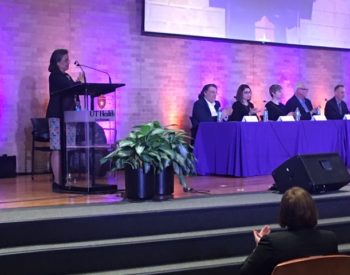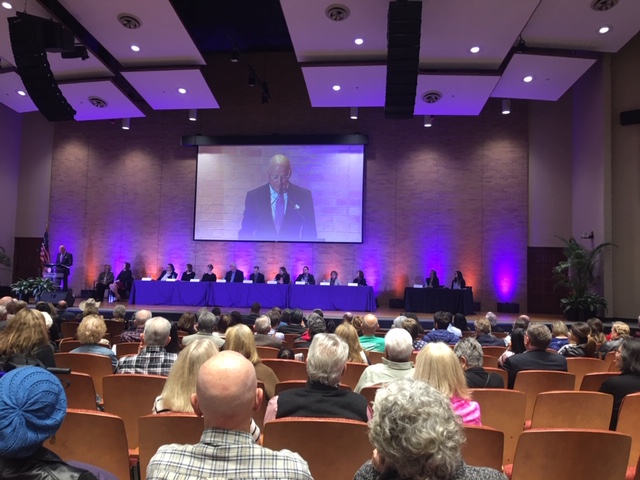“No matter how long it takes, no matter how much it costs, UT Health and I are in this fight until we win. This disease motivates us to expend our maximum energy at every moment, because there is so much at stake and there are so many depending on us.”
With those words, William Henrich, M.D., president of UT Health San Antonio, opened “Reasons for Hope,” a panel discussion on dementia on the Long Campus.
About 300 members of the community attended. Some grown children brought their senior parents.
The Glenn Biggs Institute for Alzheimer’s and Neurodegenerative Diseases organized the event, where several of the world’s leading experts discussed reasons to be hopeful in the fight against dementia.

“Together we will keep fighting, and I am hopeful that we will find answers for us and for the world,” said Biggs Institute Director Sudha Seshadri, M.D., professor of neurology in the Long School of Medicine at UT Health San Antonio.
Dr. Seshadri, along with David Martin Davies of Texas Public Radio, moderated the panel discussion.
Funding for Alzheimer’s and dementia research is at unprecedented levels, speakers said.
National Institutes of Health spending on dementia research has increased sevenfold, from $400 million a decade ago to $2.8 billion in 2020, said panelist Jason Resendez, chief of staff of the Us Against Alzheimer’s organization and executive director of the Latinos Against Alzheimer’s Coalition.
Rebecca Edelmayer, Ph.D., represented the event’s primary sponsor, the Alzheimer’s Association, on the panel.
Dr. Edelmayer, director of scientific engagement in the Chicago office, said she expects dementia to be treated through a combination approach of medicines, modifiable lifestyle interactions and risk-reduction strategies. “That is coming down the pike and will change the game in how we treat the disease in the future,” she said.
Gregory Jicha, M.D., Ph.D., of the University of Kentucky, said an increasing number of basic science discoveries are ready to be translated into practical application. He said dementia research is advancing so quickly that it isn’t unrealistic to think a solution is right around the corner. “Don’t be on the hope scale, be on the confidence scale,” he said. “The cure is coming, and it is coming soon. We need to work together.”
Jeffrey Kaye, M.D., of Oregon Health and Science University, said, “incremental advances will transform dementia into something that is much more manageable and something we are not as frightened of, frankly.” Dr. Kaye leads studies of smart technologies to improve the assessment of dementia in individuals and to aid in their care.
Gladys Maestre, M.D., Ph.D., of The University of Texas Rio Grande Valley (UTRGV) School of Medicine, said researchers can, from parts of cells called organelles, reconstruct “a little part of the brain” to be a model system on which new medicines can be tested. This is an exciting development, she noted.
Carole White, Ph.D., RN, of the School of Nursing at UT Health San Antonio, said it is hopeful that more families are seeking help and that programs are in place to support families for a better quality of life.
Dementia’s toll
The discussion turned to Latinos, who have more diabetes and uncontrolled hypertension than non-Hispanic whites, studies indicate. Physicians treating Latino patients see a pattern of diabetes, hypertension and depression that can then lead to dementia, Dr. Maestre said. This is repeated in some caregivers, she noted.
“Not only do Latinos have more dementia, but it presents seven years earlier,” she said.
By 2030, nearly 40% of all Americans living with Alzheimer’s will be Latino or African American, Resendez said. The top risk factor for Alzheimer’s is advanced age, and the number of Latinos 65 and older will grow 225% over the next decade compared to non-Hispanic whites 65 and older, he said. “We are demographically in the cross-hairs of this disease at increasing rates,” he said.
Mercè Boada Rovira, M.D., Ph.D., of the University of Barcelona, said Alzheimer’s is not just a disease, it is a social justice problem.
Scientific presentations
Following the panel discussion, more than 200 scientists and clinicians from multiple continents met for a two-day international symposium at the Briscoe Western Art Museum. The Alzheimer’s Association served as lead sponsor of the South Texas Alzheimer’s Conference, with support also coming from the UTRGV School of Medicine and The University of Texas at San Antonio.
Biggs Institute background
Five years ago, UT Health San Antonio dedicated itself to finding cures for dementia and serving as a comprehensive resource for patients and families. The university established the Biggs Institute in honor of admired community leader Glenn Biggs, who was diagnosed with Alzheimer’s disease and sought answers.
Mrs. Ann Biggs spoke to the audience and said her husband would be proud of the Biggs Institute and its first efforts.
Multiple clinical trials are now offered through the institute, community programs including a Memory and Music series are provided, and scientific investigations of Alzheimer’s disease and dementia are accelerating thanks to a cadre of talented researchers.
“San Antonio has to lead, and not follow, in this fight,” Dr. Henrich said.
In her welcome remarks, Margaret Barron, regional lead of Texas and executive director of the Alzheimer’s Association, said the Biggs Institute is a strong partner with the association and efforts are increasing.
Singer Clifton Jansky of San Antonio closed the event with a poignant song that expresses what a devoted caregiver would say to a loved one with dementia: “Don’t worry, I’ll do the remembering.”
Getting connected
Families who want to inquire about clinical trials are invited to call the Biggs Institute at 210-567-8229 or visit BiggsInstitute.org. Upcoming events are also listed on the website.


